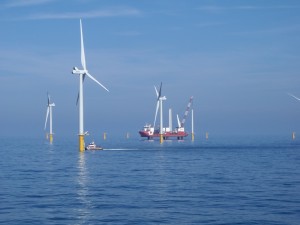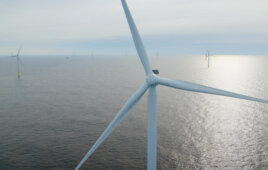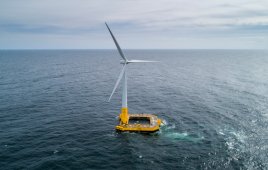From Business Network for Offshore Wind
The United States will follow some European practices to plan, construct and maintain its offshore wind projects, but it will not completely copy the European offshore wind industry model, creating opportunities for innovation in all sectors of the supply chain. For that reason, the Network heavily promotes innovation and the use of technologies from all sectors to reduce costs.

Based on Europeans meeting their targeted goals, offshore wind will generate electricity at 13¢/kwh by 2020, according to Don Hairston, President of Meggitt, a “smart engineering” company.
The Business Network for Offshore Wind organized a meeting between representatives of NASA’s Langley Research Center and its members including university scientists and researchers and business owners. This first meeting between the organizations was a roundtable discussion regarding the technologies and materials NASA currently has, what NASA could potentially produce, and how future innovations could directly invigorate the progression of the offshore wind industry. The driving idea was innovation. Innovation needs research and the appropriate application. Innovation needs people who are willing to find 10,000 ways on how to not do something, and – for an industry in its infancy – it needs people who are willing to communicate and collaborate, bringing the needs of the industry to the forefront to be tackled appropriately.
Based on Europeans meeting their targeted goals, offshore wind will generate electricity at 13¢/kwh by 2020, according to Don Hairston, President of Meggitt, a “smart engineering” company. The current price is still on the higher end of the scale, with the wholesale market price of natural gas at 3¢/kwh. All innovative developments discussed at the meeting were geared to driving this cost down, through effective partnerships leading to creative solutions to various areas of opportunity within offshore wind. If the overall process of harvesting wind is improved through innovation, then that overall price will drop significantly.
Mark Rice, Founder and President of Maritime Applied Physics Corporation, identified five specific areas that would benefit from immediate innovation: lightning strike prevention & recovery, airborne LiDAR, use of NASA’s wind tunnels to test out potential turbine designs, coatings for turbine blades, and unmanned vehicles for safer operations and maintenance.
In response, Harry Belvin, Deputy Director for the Office of Strategic Analysis, Communication and Business Development at NASA Langley Research Center (LaRC), identified technologies and competencies in which LaRC can contribute to the offshore wind sector, including research and development into advanced composites and creating new material forms, applying autonomous robotic systems to automate inspections and monitoring that mitigate hazardous and expensive human involvement; along with coating materials, sensors, computer control systems and other capabilities to improve performance and lower costs in this new industry supply chain.
“This meeting is another example of how the Network promotes collaboration between its Members and federal R&D Laboratories. We have met with US DOE, National Renewable Energy Laboratory (NREL) and now NASA Langley Research Center (LaRC). We focus on working with partners, where together the organizations will drive meaningful outcomes and shape the future for offshore wind,” said Liz Burdock. The meeting’s purpose was to initiate meaningful conversation within offshore wind and NASA LaRC, an organization with the resources to not only adapt existing technologies to offshore wind needs, and an appropriate organization to bring experimental ideas to the table. Because of these efforts, LaRC and the Network are working together and exploring future collaboration, along with encouraging working relationships with Network members–colleges, research facilities, and business owners of various sizes—to develop the innovation that will lead the industry into the future.
Since the meeting, the Office of Innovation at LaRC has created an internal technology competition to promote commercialization of LaRC technologies in the areas that will benefit offshore wind, advanced manufacturing and UAVs. Network members are serving as part of the judging panel for the competition. The winners will then receive intensive assistance from May to September to get them market-ready for licensing and will make presentations to the larger offshore wind industry at the 2016 International Offshore Wind Partnering Conference. More information is available at www.2016ipf.com including a detailed agenda.
Filed Under: Construction, News, Offshore wind




